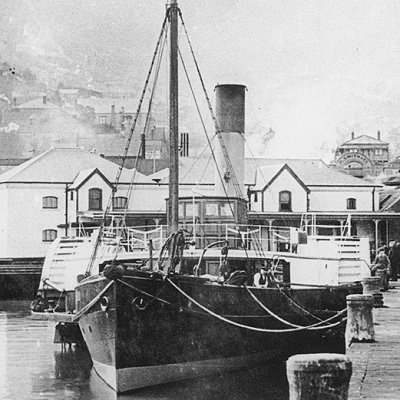Although the history of the restored and widely known fourth Lyttelton tug is well recorded, the stories of her predecessors have not previously been documented.
The Mullogh

In 1859 Dalgety, Buckley and Company, local agents for the Shaw, Savill Shipping Company, purchased the four year-old Belfast built steamer Mullogh in order to tow passenger vessels up to the anchorage in the vicinity of the Government Jetty and Peacock's Wharf. With a crew of five, a length of 60 feet and a Beam of 15 feet, the Ketch rigged iron steamer was propelled by a 15 nominal horse power, single horizontal cylinder steam engine and could carry a cargo of 60 tons.
The single screw steam ship, whose bones now lie on Lyttelton's Quail Island, served in a variety of roles, often carrying the early immigrant's heavy luggage and kitset houses up the Heathcote to Woolston or to The Bricks wharf on the Avon (where the Barbadoes Street bridge now stands). Among her more notable cargos was New Zealand's first railway locomotive and the statue of John Robert Godley that now adorns Christchurch's Cathederal Square.
Ownership of the Mullogh eventually passed to the brothers John and Peter Cameron, coastal traders with a wide variety of business interests on Lyttelton's Norwich Quay and also at Diamond Harbour, where they had built a 140 foot wharf. The Cameron's continued with the Mullogh in the tug service, expanding their fleet with the acquisition of the Paddle Tug Titan in 1876.
The Titan

As Yard No 157, the Titan had been launched from the Clydeholm Shipyard at Whiteinch on the River Clyde in November, 1866 by Barclay Curle and Company as a speculation for James Cowan of Leith. The 97 ton vessel was immediately sailed out to Melbourne, Australia, where she was sold by auction on the 22nd of July 1867 to John & David Spence, who used the 95 foot, 6 inch steamer to tow large sailing vessels from the Port Philip Heads to Williamstown and Sandridge.
Also fitted with passenger accommodation, the clinker-built iron paddle steamer was propelled by a pair of horizontal steam engines, with single 28 inch diameter cylinders and a 50 inoh length of piston shaft. Developing 55 nominal horse-power she was quite capable of being worked up to 150 horse-power. Beyond the 35 foot engine room was a dry-bottomed boiler containing 160 horizontal iron tubes. A working pressure of 25 pounds per square inch drove 14 foot 9 inch diameter paddle wheels, which were 6 feet 8 inches wide. This enabled the vessel to maintain a speed of 10 knots for up to six days from the 23 tons of coal in her bunkers.
In 1873 the Titan was purchased for £7,600 by the Westland Steam Tug and Freight Company of Hokitika. Her shallow Draft of 4 feet 6 inches made the vessel ideal for working the notorious Bars of the West Coast ports and Captain Hugh B. Macmeikan charged 2 shillings and 6 pence per registered ton to tow vessels in and out of Westport, Greymouth and Hokitika. However, business wasn't that good and less than three years later she was seized by the Mortgagor and sold by Tender to Lyttelton's Cameron Brothers by the Bank of New South Wales.
Under the succesive commands of Captains Peter and J. S. Cameron the Titan towed sailing vessels in and out of Lyttelton Harbour from 1876. Two years later the Cameron's tugs were in competition with the Harbour Board's new and larger vessel. Although offered for sale, along with the Mullogh, by private tender in September, 1878, no buyer was found for the Titan and she continued in the Lyttelton service until 1882, when she was purchased the Timaru Harbour Board for £3,500.
In the command of Captain Clarkson the paddle tug was still towing ships in and out of Timaru in 1889, but her annual survey in that year indicated that although her engines were in good order, the boiler and hull were likely to require a major overhaul. By about 1893 she had been converted to a coal hulk and in 1895 the Titan was sold to the Bluff Harbour Board. Abandoned at the head of Bluff Harbour about 1901, her bones may still be visible on the beach.
The Lyttelton

Established in 1877, one of the Lyttelton Harbour Board's first significant undertakings was to order a tug at a cost of £9,000 from the Laird Brothers of North Birkenhead (opposite Liverpool on the River Mersey). Delivered at London in July, 1878 and rigged as a Brigantine, the Lyttelton arrived, under sail, at Cooktown, in the far north of Queensland for provisions four months later. Proceeding to Brisbane for ballast Coal, the Lyttelton arrived at her home port via Wellington and Blenheim on the 21st of November, 1878.

Lyttelton at Wellington on her delivery voyage, via Blenheim.

Lyttelton at Port Levy, Banks Peninsula, circa 1900.

Lyttelton at the Auckland Anniversary Day Regatta, January 1912
Five years later she passed to the Kauri Timber Company and saw active service towing rafts of Kauri logs between Whangaroa and the Coromandel ports. Laid up in 1941 at Auckland's Western Viaduct, her superstructure was destroyed by fire in 1945.
On the 5th of October, 1955 the vessel was towed across the Hauraki Gulf and run ashore at Lagoon Bay on Coromandel's Takatu Peninsula, where she was used as a shingle hopper for the Subritzky Shipping Company's scow Jane Clifford. When that industry declined in the mid-1970s the hull was left to become slowly buried in shingle drifts.
No comments:
Post a Comment